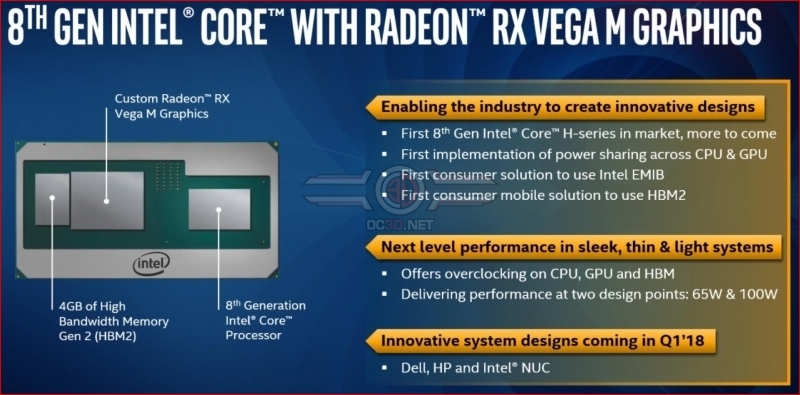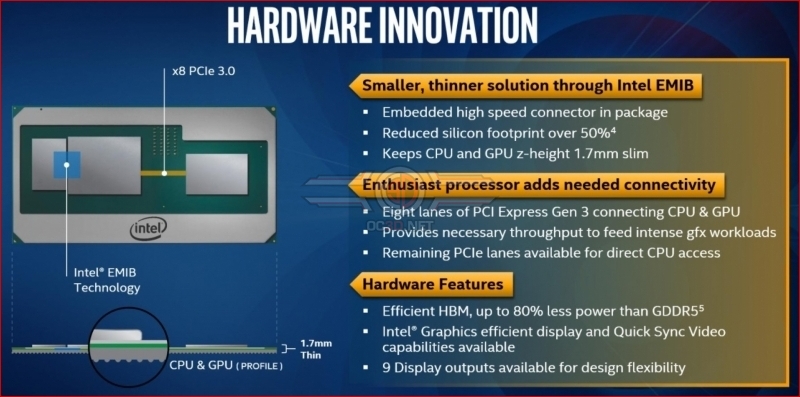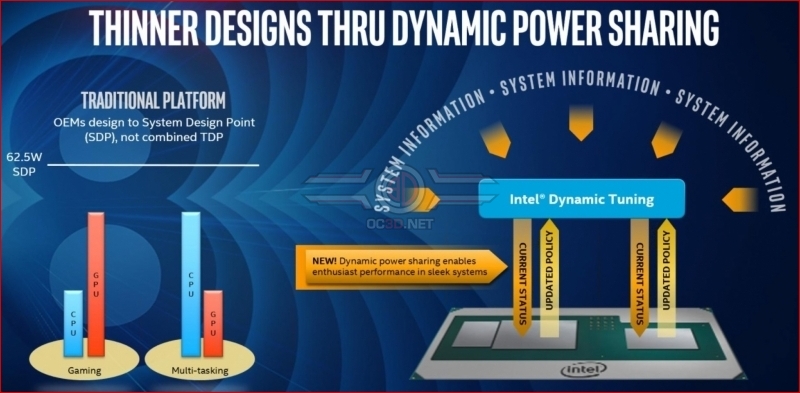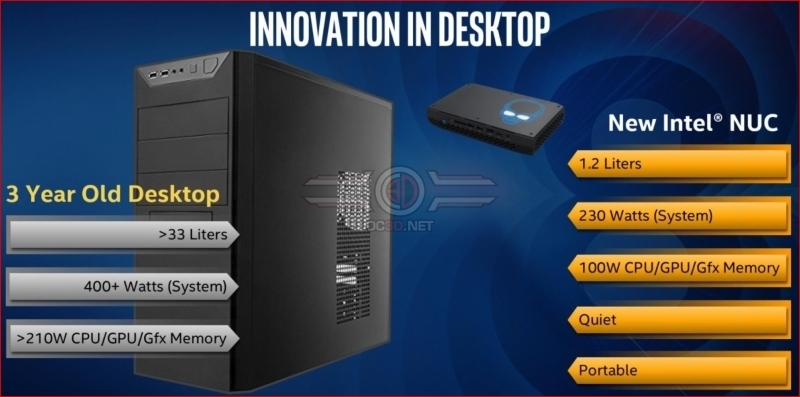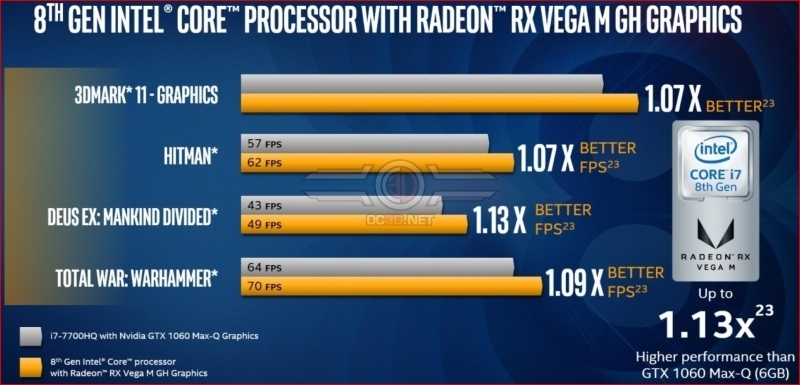Intel reveals their 8th Gen Intel Core G-series processors with RX Vega M Graphics
Intel reveals their 8th Gen Intel Core G-series processors with RX Vega M Graphics
This new line of products is Intel’s G-series, a product that combines Intel’s Kaby Lake CPU architecture and AMD’s Vega graphics architecture to create an extremely small SoC that will bring game-ready performance to smaller systems than ever before.Â
The new 8th Generation G-series of processors will combine new technologies from rival brands in astounding ways, creating something that is arguably greater than what either AMD or Intel can build on their own.Â
 Â
In simple terms, this new product is a Vega dedicated graphics chip that is placed beside an Intel 8th Generation H-series CPU on the same package, though that undersells what has been done here.Â
This product is the smallest package to offer this level of both CPU and graphics performance on the market, enabling thin and lite builts to either become smaller or allow existing product sizes to facilitate larger batteries and/or larger cooling units.Â
The G-series is also the first consumer product to use Intel EMIB technology, allowing multi-die chip designed to be connected without an interposer. EMIB technology attaches Intel’s Custom Radeon Vega GPU with 4GB of HBM2 memory, making the product easier to manufacture than interposer-based designs like the RX Vega 56/64. Â
Â
Intel uses eight PCIe lanes to connect their CPU to their Custom Radeon Vega M series GPU, with remaining PCIe lanes being used to connect other devices like NVMe storage.Â
The use of HBM2 memory is said to reduce memory related power consumption by 80% when compared to GDDR5, though please note that the 4GB of HBM2 used in this SoC is used exclusively by the Vega graphics unit.Â
Up to nine displays can be connected to this SoC, with six being usable on the Vega graphics chip and three being usable on the Intel iGPU inside the Kaby Lake H-series CPU.Â
Â
Vega features – Dynamic power saving
One of the most interesting features of this product is its dynamic power tuning features, allowing OEMs to select an SDP (system design power) to regulate how much power the system uses. From here the SoC will dynamically shift power to the CPU and GPU to deliver optimal performance within a specific power envelope.Â
SDP is not the combined TDP of both products, though certain Intel G-series processors will be overclockable, both on the CPU and GPU side.Â
Intel’s unique power saving system allows their custom SoC to deliver the same performance using 17.5 fewer wats than without it, offering an efficiency increase of 18%. This increase in efficiency is excellent news for those that want to save power, particularly mobile users who wish to increased battery life.Â
Both the Vega graphics unit and the Intel integrated graphics units on this SoC are enabled, allowing this SoC to support Intel QuickSync using the Intel iGPU as well as technologies like AMD FreeSync when using a display connected to the Radeon Vega graphics chip. Â
Specifications and form factors – Notebooks and Nucs
This SoC will come in both 100W and 65W TDPs, with both i5 and i7 versions. All CPUs will offer four cores and four threads, though each model will provide different clock speeds and Radeon RX Vega M GPU configurations.Â
Two RX Vega M GPU versions will be available, a fully unlocked version called the RX Vega M GH (Graphics High), and a lower-end version called the RX Vega M GL (Graphics Low), offering peak SP performance of 3.7 TFLOPS and 2.6 TFLOPS respectfully. The High-end model will offer higher clocked HBM2 memory and a higher ROP count, giving it more advantages than just a simple boost in clocks and active Compute Units.Â
With either 20 or 24 active compute units the most directly comparable GPUs are the RX 560 with 16 compute units and the RX 470/570 with 32 compute units, though it is worth noting that both of these GPUs are based on AMD’s older Polaris GPU architecture. Â
Â
Intel sees these new SoCs as delivering more performance than three-year-old mainstream gaming desktops and notebooks, offering smaller/thinner form factors and lower levels of power consumption.Â
This new SoC will come in new notebook designs, with models from Dell and HP coming soon, as well as in Intel’s new Hades Canyon Nuc platform.Â
Â
One of the first places where Intel will be using the 100W version of their G-series processors is with their new Hades Canyon Nuc, which is completely unlocked to allow for both CPU and GPU overclocking. Please note that on the 100W i7-8809 SoC is unlocked, with lower end models lacking support for overclocking.
Â
Intel Performance Comparisons
Intel has released some early performance numbers for their new SoC, comparing it to systems using older Intel CPUs with Nvidia Graphics. Below is a use-case that compared Intel’s i7 4720Hq with a GTX 950M to an Intel 8th Generation processor with a Radeon RX Vega M GL graphics processor.Â
This comparison gives Intel a significant lead, which when combined with the power and spatial saving offered by Intel new unit makes this product extremely compelling.Â
Â
Â
This second comparison compares this same unit with an RX Vega GL graphics chip to a newer Intel system with an i7 8550U and a GTX 1050 Graphics card, with the new Intel SoC offering a 10-40% performance advantage.Â
Please note that Vermintide 2 has not been released, so the game’s relative performance could change with additional optimisations and development time.Â
The comparison below compares a three-year-old notebook with an i7 4720HQ and a GTX 960M GPU with a system with an 8th Generation Intel core processor with an RX Vega M GH graphics unit, delivering an impressive performance gain in gaming applications.Â
This SoC seems ideal for 1080p 60FPS gameplay, provided users are willing to tinker with their graphical settings a little.Â
Â
Things remain impressive when this new unit is compared to a Nvidia GTX 1060 MaxQ based system, with the all-Intel (well, arguably Intel/AMD) system offering a notable performance advantage. Not bad for a CPU/GPU combo in a single package.Â
Drivers, VR and ConclusionÂ
One of the big questions about this unit is how Intel is handing drivers with the new SoC. Would Intel handle drivers on their CPU/GPU and leave the Vega graphics to Radeon, or will Intel handle the lot?Â
The Vega graphics card will support features like Radeon Wattman, Chill, ReLive and FreeSync and will use a version of Radeon Software Adrenalin, though note that this driver in the image below has a hint of Intel Blue on it. Yes, the driver is Radeon Software Adrenalin, but it will be packaged and distributed by Intel.
This means that Intel will be handling all potential complaints but Radeon will be updating Intel with new features and game optimisations. Intel will be responsible for releasing new drivers and managing quality control, which could be concerning given their track record with GPU drivers, though at least they are promising Day-0 releases for upcoming games, which is encouraging.Â
As part of their business arrangement, AMD will be delivering their driver updates to Intel, including any new features that AMD brings to their Vega products. It is then Intel’s job to make any adjustments they wish and re-brand the driver for their own release.Â
These new chips will feature support for overclocking via Intel XTU and Radeon Wattman, but only when using select SKUs (The 100W variant).Â
Â
This SOC is not exactly what we would define as VR Ready, falling under the high system requirements for the HTC Vive (GTX 970 or R9 390 or higher), though they do surpass the requirements for Windows Mixed Reality and the Oculus Rift.Â
The transformative nature of this product cannot be understated, allowing a Vega GPU to connect to HBM2 memory without an interposer, save power by combining technology from rival companies with a unique dynamic power system and delivering game-ready performance into an incredibly small package.
We look forward to seeing both compact systems and notebooks that will be powered by this custom CPU/GPU package, though you can bet on Apple picking up this design for their next MacBook Pro iteration.
You can join the discussion on Intel’s new 8th Generation G-series of processors on the OC3D Forums.  Â





